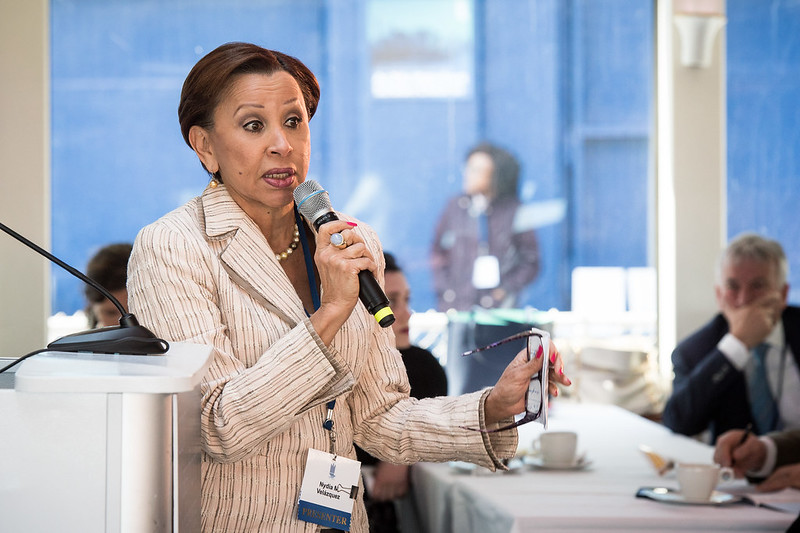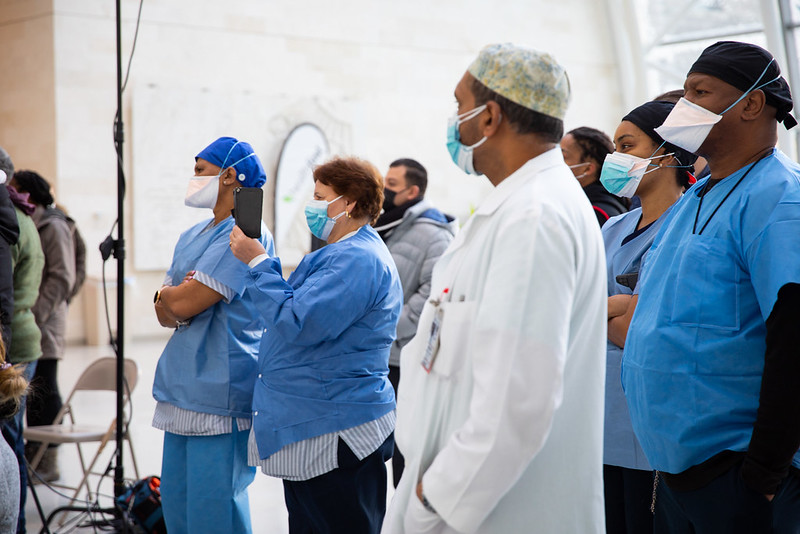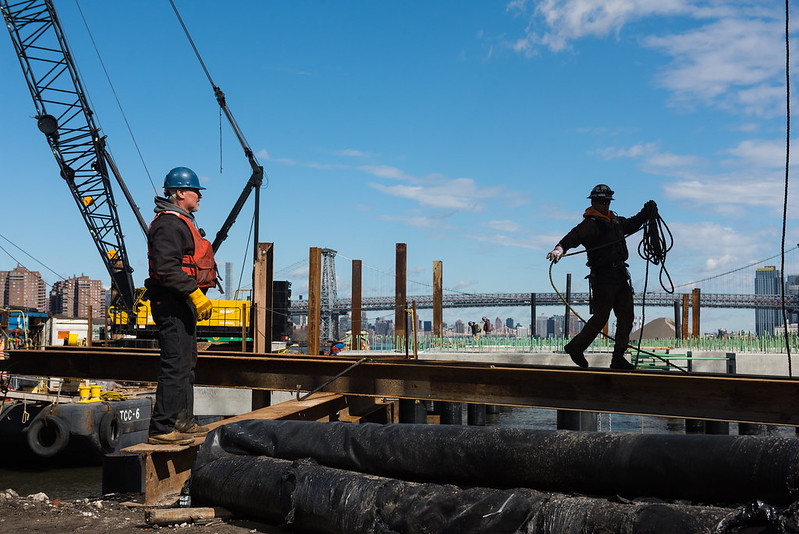Redistricting and Latinos in New York

Rep. Nydia Velázquez (photo: Ian Douglass/Waterfronts)
The New York State Legislature has passed, and Governor Hochul has signed, new district maps for the House of Representatives, the State Assembly, and the State Senate. What do these new lines mean for Latino representation?
While space limitations prohibit me from providing an exhaustive analysis, several new district lines are worth noting. Let us begin with Congress.
Of all New York City’s four congressional districts represented by Latinos, Congressional Rep. Nydia Velázquez’s district has undergone the most deviation from its previous contours. Rep. Velázquez was the first Puerto Rican Latina to be elected to Congress. It appears that her district—New York’s 7th Congressional District, covering parts of Brooklyn, Manhattan, and Queens, and with a Latino plurality—has borne the brunt of congressional district changes in the city, a result of deliberate maneuvering in order to make the 11th Congressional District more suitable for a Democratic retaking.
The 11th is currently represented by Rep. Nicole Malliotakis, a Republican and half-Cuban Congress member. NY-11 is the only congressional district in New York City currently represented by a Republican.
Several neighborhoods in NY-7, including Sunset Park and Red Hook, with their sizable Latino presences, have been drawn out of Velázquez’s district and into Malliotakis’. Rep. Velázquez has represented Sunset Park since her election to Congress in 1992 and the neighborhood was included in that district at a time when an additional Latino-majority district was sought. Current opponents of the dismantling of parts of Velázquez’s district point to the potential of voting dilution, since Latinos in Sunset Park and other neighborhoods will now become part of a non-Latino majority district.
Despite all the changes, particularly the possibility of voting dilution, the Latino presence in the new Velázquez district among the voting population has not shifted much, increasing by 4,000 Latino voters from the current lines. The increase is a result of the new 7th district taking in other parts of Queens that Velázquez had not previously represented, namely portions of Ozone Park.
The Latino voting population in the new NY-13, represented by Rep. Adriano Espaillat, has not shifted much, and Rep. Alexandria Ocasio-Cortez’s Latino constituency in her district, NY-14, remains largely unchanged. Interestingly enough, Rep. Ritchie Torres, who represents a Latino-majority district whose Latino representation goes back to Herman Badillo, has lost 11,000 Latino voters (mostly in University Heights), while gaining an additional 18,000 white voters, largely a result of the district’s move north to include Riverdale.
In relation to Latino politics and representation, perhaps the more drastic changes to district lines can be found in the Senate and Assembly districts. Of New York City’s 95 state legislative districts, there are currently five Latinos in the 63-seat State Senate and 11 in the 150-seat Assembly.
Starting in Manhattan, we can begin our exploration of changes in the historic Latino neighborhood of East Harlem. If there ever were a prime example of how communities can be splintered electorally, East Harlem is the one. East Harlem, a geographically compact location that is majority-Latino with a sizable African-American population, will soon be represented by three state senators instead of the current two. Yes, three senators for one community.
Under the new lines, East Harlem will be represented in the State Senate by Senators Cordell Cleare, Michael Gianaris, and Jose Serrano, assuming they all win reelection this year. The East Harlem State Senate seat has had historic importance since Olga Mendez won the seat in 1978, becoming the first Puerto Rican Latina elected to a state legislature in the country.
In Queens, a new State Senate district has been created, what will be the 17th District, part of how the new maps reflect population shifts favoring New York City and a correction to previously gerrymandered districts to favor Republicans outside the city.
Observers note that the carving out of this seat is a result of the increase in the Latino population in Queens and that in essence this becomes a new “Latino seat.” However, the data discloses something entirely different. The Redistricting and You data, excellently compiled by Steven Romalewski at the Center for Urban Research at the CUNY Graduate Center, demonstrates that in overall population, Latinos make up 38% of the population in this new district, just a 6% increase from the current Senate lines. In voting age population, Latinos make up 36% of the population, also a 6% increase.
However, when one considers voter registration numbers, Latinos only outnumber the next highest ethnic group (non-Hispanic whites) by 894. When one takes voting participation into account, the numbers would indicate even more that this district is certainly not a “Latino seat,” at least not in the immediate future. Among Democratic voters, non-Hispanic whites in this new district outnumber Latinos by over 5,200 voters, a gap of utmost importance given how often elections in New York City are determined by the Democratic primary.
When it comes to Assembly districts, Queens may also take a hit when it comes to Latino representation. The Corona neighborhood, a mostly Latino community, will now be divided into three Assembly districts.
Most of Corona is currently represented in the Assembly by Catalina Cruz. Interestingly, Corona has produced the first Latino representatives in the borough: Hiram Monserrate (the first Latino elected in the borough) and Julissa Ferreras (the first Latina elected in Queens). Now Corona stands the chance of seeing these historic gains jeopardized, seemingly in order to protect some non-Latino incumbents in other neighborhoods.
The electoral splintering of Latino neighborhoods, in addition to the ongoing gentrification of many of these neighborhoods, does not bode well for Latino representation in the next decade. Is this a result of the lack of Latino representation at the higher levels of state government? It certainly seems that way.
***
Eli Valentin is an adjunct lecturer at Union Theological Seminary. He writes regular columns for Gotham Gazette, largely focused on Latino politics in New York City, and is a frequent guest political analyst at Univision NY. On Twitter @EliValentinNY.
***
Eli Valentin is a political analyst and author of the forthcoming book, Reinhold Niebuhr: A Political Life. On Twitter @EliValentinNY.
***
Have an op-ed idea or submission for Gotham Gazette? Email This email address is being protected from spambots. You need JavaScript enabled to view it.
History Demonstrates That Diversity Is the Future of Medicine

Health care workers on the front lines (photo: Michael Appleton/Mayoral Photography Office)
As we celebrate Black History Month, I often reminisce on the saying, "If I have seen further, it is by standing on the shoulders of giants." As a cardiologist, Vivien Thomas is one of the many African-American giants whose shoulders I’m privileged to stand on. To me, he is a pillar of cardiac surgery, a master anatomist, an exemplary scientist, and a selfless servant to others.
Mr. Thomas (please note the lack of title to his name, an issue I will touch upon below) was a laboratory supervisor who developed the first procedure in the 1940s to treat "blue baby syndrome," a heart condition that can cause the skin of babies to turn blue because of a lack of oxygen in their blood. Before his contribution, heart disease was a death sentence for those babies. Vivien Thomas holds a special place in my heart as an alumnus of my alma mater, John Hopkins University School of Medicine, where his portrait hangs today.
He served as an assistant surgeon, and what makes his story even more remarkable is that he accomplished this without a professional medical education. He was paid and classified as a janitor while helping develop this life-saving procedure. It wasn't until late in his career that the university awarded him the honorary title of Doctor.
Imagine if, for a moment, he had the formal training and resources to be a doctor, what the ramifications could have been not only for the field of medicine but his community. Studies have shown that diversity and representation in medicine matter immensely. Representation of doctors and nurses of color helps inspire the next generation of healthcare professionals. It also helps to rebuild trust between patients and their healthcare system and has been shown to improve clinical outcomes.
Even 80 years after Mr. (Dr.) Thomas' groundbreaking contributions to infant health and cardiology, serious racial discrepancies still exist in medicine. To date, African-Americans make up less than 3% of doctors in the U.S, and in my specialty of cardiology, less than 1%. This statistic should cause alarm for communities across the country, whether urban, suburban, or rural. We have a growing diverse population, and the doctors charged with tending to it may not understand cultural or racial nuisance or they might present subconscious or implicit bias when providing care.
Two studies from the New England Journal of Medicine show that African-American patients suffering from heart disease are less likely than white patients to receive invasive heart procedures such as cardiac catheterization, even when everything else between the groups is equal. Furthermore, the bias toward Black patients (whether explicit or implicit) persisted even when the treating physicians were Black.
"Factors associated with a difference in race between physicians and patients, such as cross-cultural miscommunication, 11,12 lack of rapport or trust, 13,14 and reduced willingness on the part of the patient to undergo an intervention, 15 may lead to the use of fewer medically-necessary procedures among Black patients," according to the study authors.
And a new study from researchers at the University of Chicago found that implicit bias in the medical field extends beyond the examination room and into the electronic health record (EHR). Black patients were 2.5 times more likely than white patients to have at least one negative term in their EHR.
Even knowing the numbers and understanding the effects, our nation's medical field has yet to properly address the needs at hand. Studies have shown that African-Americans are more likely to suffer from heart-related conditions like high blood pressure, diabetes, and stroke. To combat these negative health outcomes, we need more doctors who can relate to patients and give them health guidance and strategies to manage their unique journeys in a culturally appropriate manner.
As an ever-diversifying country, we need to develop an achievable and sustainable plan to better recruit and retain minority physicians in all specialties. New York City alone is -- to borrow from former Mayor David Dinkins -- "a gorgeous mosaic of race and religious faith, of national origin and sexual orientation." As of the last Census, minority groups make up over two-thirds of the city's population. Still, less than 3% of doctors nationwide are people of color, and less than 1% of cardiologists are African-American.
At AdvantageCare Physicians, where I practice, we pride ourselves on having diverse, culturally competent medical professionals who identify with or come from the communities where they provide care. Yet our field as a whole still has much more work to do in New York City and throughout the country.
The face of the nation is changing. Our national population grew by over 7% since 2010, according to results from the 2020 U.S. Census. These changes mean that our approach to every facet of life, including providing proper health care, needs to evolve. The next great minds to help address this challenge are out there. We need to find, nurture, and grow them to be ready to join us.
Over the last century, countless institutions throughout our country have contributed ground-breaking work in the fields of cardiology and medicine, including the life-saving surgeries for “blue babies” at Johns Hopkins. However, we mustn’t forget the example that this work was pioneered by an outsider with an untraditional background, who faced insurmountable odds to save lives. As we reflect on Black History and on Dr. Thomas’ accomplishments, we must also contemplate how to move further with his legacy. We can start by attracting other brilliant minds from our diverse communities to help move healthcare into the future.
***
Dr. Haitham Ahmed, MD, is Chair of Cardiology at AdvantageCare Physicians, one of the largest primary and specialty care practices in the New York area.
***
Have an op-ed idea or submission for Gotham Gazette? Email This email address is being protected from spambots. You need JavaScript enabled to view it.
An ‘Opportunity’ for Bad Economic Policy

Workers on the job site (photo: Edwin J. Torres/Mayoral Photo Office)
Recently, Patrick Purcell, Jr. of the New York State Laborers-Employers Cooperation & Education Trust and Assemblymember Karines Reyes authored an op-ed regarding the Roadway Excavation Quality Assurance Act (REQAA) and its potential to positively impact the environment, the economy, and the workforce. The piece -- “An Opportunity to Boost the Environment, Economy, and Workers” -- is concerning because the authors paint an inaccurate picture, hiding the hidden detail within the legislation, the use of Project Labor Agreements, that is at the center of what Mr. Purcell’s organization supports.
The full story paints a very different picture and will likely change the way readers feel about the REQAA. Mr. Purcell supports this policy and PLAs because they drive work to those he represents: a very small number of workers compared to the overall workforce in New York state.
He claims that the REQAA provides significant economic benefits and states that workers affected by this bill will “have the financial resources to patronize their hometown shops and restaurants.” This is where Mr. Purcell has left out important details.
The REQAA includes language within the bill that encourages the use of a Project Labor Agreement on these projects. A PLA is a pre-hire collective bargaining agreement that requires the hiring of union workers. The issue here is not the employment of union workers, but the required use of them instead of opening the projects up to the entirety of New York state’s construction workforce.
More than 70% of the construction industry workforce in our state is not affiliated with a union. They work for open shop contractors, the majority being small businesses. The REQAA Mr. Purcell is so fond of, includes language that discriminates against the vast majority of the state’s construction labor pool by not allowing their employers to use them on projects under these provisions.
How can any policy that stomps on businesses and prevents the majority of a workforce from working be good for the state’s economy? The authors of the op-ed omitted some very important details in pushing this legislation.
And, if it is not bad enough that the REQAA will bury businesses even deeper, consider this: when the labor pool is limited to less than 30% of the available workforce, but more workers are needed, they’ll be brought in from out of state. That doesn’t help a single worker or family in New York.
Additionally, the REQAA will ultimately hurt New York ratepayers who are already feeling the burden of some of the highest utility costs in recent years. Consumers will pay even more for utilities because, as studies show, the prevailing wage increases the cost of construction by up to 25%. It’s time for honesty: this is the reality when we force utility companies to pay more, they pass the added cost on to the ratepayers.
Instead of focusing on harmful policies, New York government should be figuring out how to cut costs for ratepayers. That can be done by lowering taxes we all have to pay on natural gas, broadband, cell phone service, electricity, and more.
Our elected officials have a responsibility to protect New Yorkers from harmful legislation while improving their quality of life. The REQAA does the opposite. It discriminates against most contractors in the state, prevents hundreds of thousands of workers and their families from benefiting from construction jobs their tax dollars are paying for, and it increases the cost of living in New York state. Our elected leaders should run far and wide from the REQAA.
***
Brian Sampson is president of The Empire State Chapter of Associated Builders and Contractors, part of a national construction industry trade association established in 1950 and founded on the merit shop philosophy. On Twitter @abcempirestate.
***
Have an op-ed idea or submission for Gotham Gazette? Email This email address is being protected from spambots. You need JavaScript enabled to view it.




